Are you new to dog nail trimming? Or perhaps you’ve tried it before but encountered signs of pain, bleeding from the nails, or fearfulness from your pup. Whatever starting point you may be in, this complete guide on how to trim a dog’s nails by Sploot Vets answers a common question among pet parents: how do you cut a dog’s nails?
We also address common nuances like how to cut black dog nails, which can be more challenging, and how to deal with fear.
What’s in This Guide?
- Dog Nail Trimming Fundamentals
- How Do You Cut a Dog’s Nails?
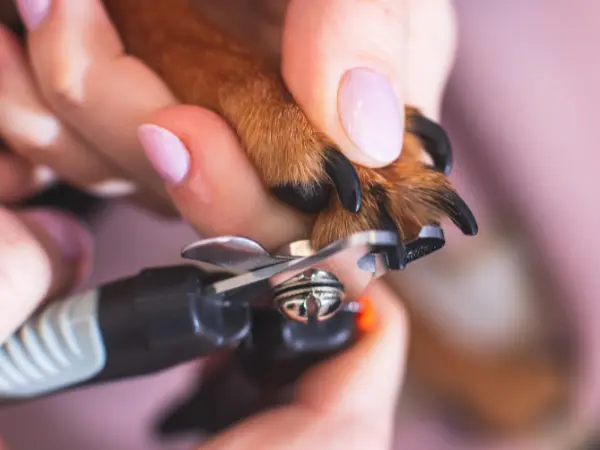
Dog Nail Trimming Fundamentals
Before we proceed to the steps on how to cut a dog’s nails, here are a few fundamentals you need to know.
A. Why Cut Your Dog’s Nails
Without regular trimming, a dog’s nails can become overgrown. Overgrown nails often drag against the ground, causing pain, affecting mobility, and prone to breaking.
In addition, regular nail trimming for dogs makes the process easier moving forward, for two reasons:
- Positive conditioning — when combined with positive reinforcement, regular nail trimming will allow your pup to get used to the process and cooperate.
- ‘Quick’ maintenance — the quick is the part of the dog’s nails that has blood vessels and nerves. Hitting the nail’s quick results in pain and bleeding; therefore, avoiding this part of the nail is important. Regular nail trimming keeps the quick short — whereas overgrown nails will have longer quicks that are more difficult to avoid.
B. Can I Cut My Dog’s Nails Myself?
Generally, it’s perfectly fine to cut your dog’s nails at home, as long as their nails are a healthy length and the proper dog nail trimming techniques are used. In addition, make sure to only use a nail clipper or nail grinder that is suitable for dogs.
Note: If the dog’s nails are overgrown or broken, bring them to a vet. Overgrown nails likely have an overgrown quick (the part of the nail with blood vessels and nerves) —and trimming overgrown nails down will likely expose the quick and lead to bleeding. Meanwhile, broken nails are prone to infection and may require treatment.
C. When to Cut a Dog’s Nails (& Dew Claw) — Monthly or As Needed
The recommended frequency for dog nail trimming is once a month. For some dogs, this coincides with their scheduled monthly baths. If so, it would be best to cut the dog’s nails after their bath, since water softens the nails, making them easier to trim.
Pet parents may also cut their dog’s nails as soon as they grow too long. The ideal length for a dog’s nails is slightly longer than the quick, but not touching the ground when the dog is standing.
But what about the dew claw, the nail found on the side of the dog’s leg, higher than their paws? Should that be trimmed too? The answer is yes, dew claws in dogs also need to be trimmed, along with the nails on the dog’s paw. The ideal length for the dew claw in dogs is slightly longer than the nail’s quick, but NOT too long that it curls on itself or goes past the line of the leg.
Note: Dog nail trimming should only be done on adult dogs and puppies 8 weeks of age or older unless otherwise recommended by your veterinarian.
D. Is The Cutting of Nails in Dogs Painful?
With the right tools and proper technique, trimming a dog’s nails should be painless and free of bleeding, as long as you avoid cutting the quick—the sensitive area containing nerves and blood vessels.
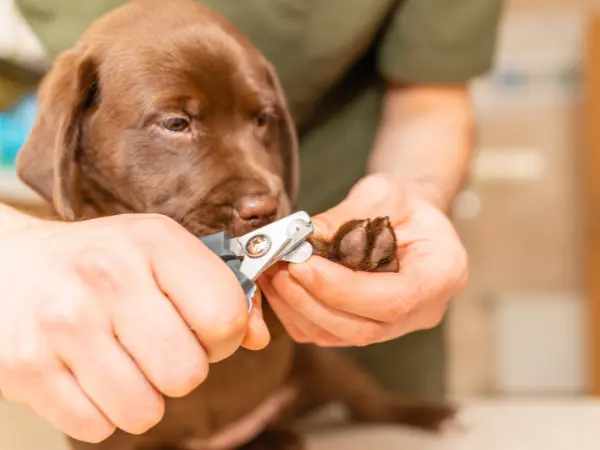
How Do You Cut a Dog’s Nails?
1. Choosing a Nail Clipper or Nail Grinder
You can use either a nail clipper or a nail grinder, depending on what your pup is more comfortable with and your preferences. Consider the following benefits:
Benefits of Using a Dog Nail Clipper
Dog nail clippers are silent and don’t rely on batteries or charge. Nail clippers also come in various types. One commonly preferred variety is the guillotine-type nail clipper, which has a hole where the dog’s nail should go; they are generally easy to use.
Another commonly used variety is the scissor-type dog nail clipper with scissor-like handles which helps with precision cuts, such as when trimming the dew claw.
Benefits of Using a Nail Grinder for Dogs
Nail grinders for dogs gradually file down the nail and can be gentler, especially for dogs who are sensitive to clipping. Nail grinders also produce a rounded nail’s edge, instead of a sharp edge after clipping.
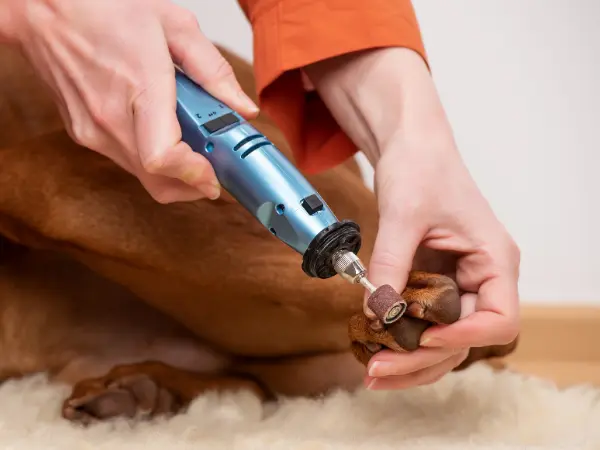
2. How Do I Get My Dog to Let Me Cut His Nails? [Addressing Fear]
Addressing a dog’s fear of nail trimming requires patience and positive reinforcement. Start by gradually introducing the process over several days.
Begin by doing the following one at a time, over a few days — and give your dog treats and praise after each action:
- Gently touch their paws — front and back.
- Let them sniff the nail clipper or nail grinder.
- Touch the nail clipper or nail grinder on their paws.
- Turn on the nail grinder or handle the nail clipper without trimming any nails.
3. Prepare Your Materials for Dog Nail Trimming
Before starting the nail trimming process, make sure you have everything ready. Having your materials prepared will help the experience go smoothly and reduce stress for both you and your dog. Make sure to have the following:
- Your chosen nail clipper or grinder
- A leash (if necessary to keep your dog in place)
- A supply of treats to reward your dog throughout the process.
- Dog-friendly styptic powder to help stop the bleeding in case the quick gets cut. At Sploot, we use Kwik Stop.
4. Make Sure Your Dog is Calm
It’s essential to ensure that your dog is calm before beginning the nail trimming. As mentioned earlier, dog nail trimming after a bath is ideal because the nails are softer and your dog is likely more relaxed. If your dog is anxious, take time to soothe them before proceeding to avoid any sudden movements or resistance during nail trimming.
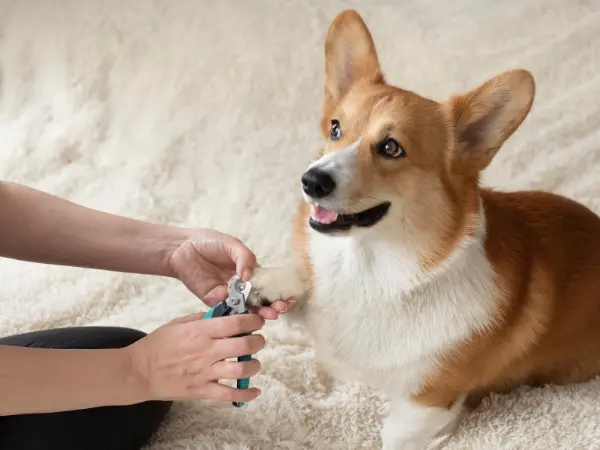
5. Get a Good Hold of Your Dog’s Paw
Once your dog is calm and ready, firmly hold one of their paws. Also, grasp the digit where the nail will be cut. Holding both their paw and the digit securely will help prevent sudden movements that might cause accidental cuts.
6. Cut or Grind Each Nail
When trimming, be sure to avoid the quick, the sensitive area of the nail that contains blood vessels and nerves. Cut the nail straight, at least 2mm after the quick. The nail should NOT extend beyond the digit’s pad.
Make sure to reassure your dog and give them treats every now and then to help them form a positive association with this activity.
Note: As a reminder, if your dog’s nails are severely overgrown or broken, take them to a vet. Overgrown nails may expose the quick when trimmed, causing bleeding — while broken nails risk infection.
7. How to Cut Black Dog Nails
For dogs with black nails, where the quick is harder to see, cut the nail gradually. When you are still NOT close to the quick, the inside of the nail would be light-colored. Cut gradually until the center starts to appear darker — this is a sign that you’re getting close to the quick, and you should stop trimming.
Note: In addition to the above, you can shine a flashlight under the dog’s nail to help figure out where the quick ends.
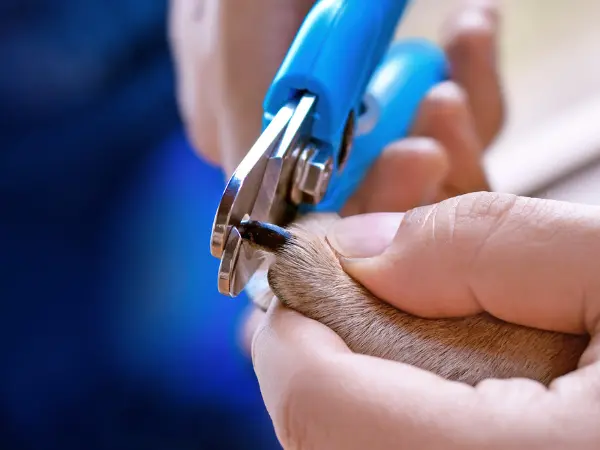
8. In Case of Bleeding: Using Styptic Powder
If you accidentally cut into the quick and your dog’s nail starts bleeding, don’t panic. Apply a small amount of styptic powder directly to the bleeding nail and gently press it into the area for a few seconds. If you don’t have styptic powder, cornstarch or flour can be used as a temporary alternative.
Note: If the bleeding doesn’t stop after 10 minutes, contact your vet for further advice to ensure your dog’s safety and prevent any complications.
9. Wrapping Up With Treats & Praise
After each nail is trimmed, reward your dog with more treats and plenty of praise. Positive reinforcement throughout the process of dog nail trimming will help your dog form a positive association, making future trims easier.
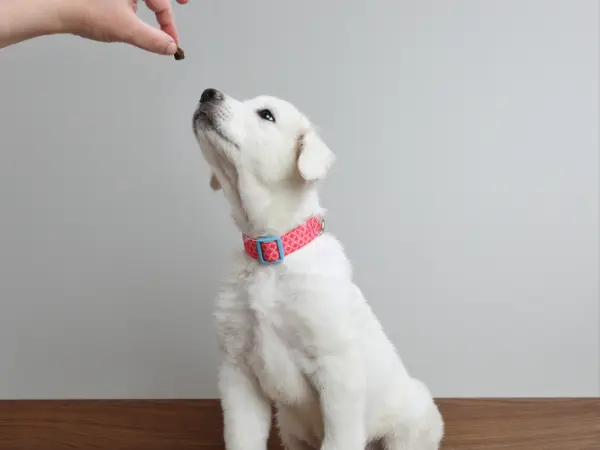
Final Thoughts on Dog Nail Trimming
This wraps up our guide on how to trim a dog’s nails. If you have further questions or need assistance with overgrown, broken, or bleeding dog nails, we’re here to help.
Sploot Vets is your go-to vet for all-in-one care. We offer primary, urgent, and emergency vet services, for extended hours, 365 days a year. We have conveniently located, Fear Free vet clinics across Denver and Chicago.
Experience next-level, convenient vet care today! Book an appointment online or through the Sploot Vets petcare app. As always, we’re with you every pounce of the way!
